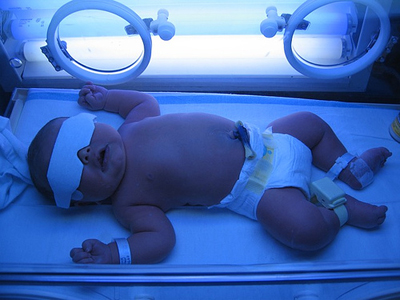
It usually does not cause problems and generally fades by the end of the first week after birth. If the jaundice doesn’t start fading after a week, or is still present after two weeks, contact your doctor or local hospital.
What causes the yellow colour?
In the human body, new blood is being made all the time and old blood is being destroyed. One of the products of destroyed blood is called bilirubin. Bilirubin normally goes to the liver and then leaves the body in the poo. For the first few days after birth a baby’s liver does not work as well as it does later, so there tends to be a build-up of bilirubin in the blood. This causes the yellow colour in the skin and white of the eyes.
Is jaundice harmful?
If the amount of bilirubin level gets too high it may make the baby drowsy. Very high levels can lead to hearing problems and brain damage. In hospital, care is taken to ensure that the bilirubin level does not get too high. Jaundice may also be due to liver disease. This is why it is important to contact your local doctor. One of the signs of liver disease would be your baby’s poo being very pale rather than a
rich yellow colour.
Which babies get high levels of jaundice?
Babies who may be more likely to get jaundice include:
-
Premature babies
-
Babies with an infection
-
Rhesus or RH babies – babies with one blood group different from their mother’s. Due to this a reaction occurs in which the baby’s blood cells are destroyed more quickly.
Measuring how much jaundice the baby has
A blood test checks the bilirubin level. Some hospitals also use an instrument placed on the baby’s skin as a screening test to help decide if a blood test is needed. Hospital staff will do a blood test if:
-
There are risk factors present such as prematurity
-
Jaundice is present within the first few days of life
Treatment
Good fluid intake is essential for newborn babies. Jaundice is often exaggerated with mild dehydration. Mild jaundice in the first week needs no treatment except fluids. Moderate jaundice is treated by placing the baby naked (with a protective mask over the eyes) under a bright light or a bluish-coloured light. This is called phototherapy.
The light breaks down the bilirubin in the skin and makes the jaundice fade. This light treatment may cause the baby to have loose poo. This is dealt with by increasing the baby’s fluid intake. Unsupervised exposure to direct sunlight can be harmful causing sunburn. In severe jaundice the baby may need to have a special blood transfusion in which the baby’s blood is replaced (exchanged) with fresh blood to wash the bilirubin out of the system.
Are there any long term problems from jaundice?
There are usually no long term problems following jaundice in babies. Babies who have had high levels of jaundice should have their hearing checked at regular intervals. This is best discussed with your doctor or early childhood nurse. Brain damage due to very high levels of jaundice is now extremely rare because the levels are carefully monitored during the first few days of life in hospital or at home with an early discharge program.
Remember
-
If the jaundice doesn’t start to fade after a week, or persists after two weeks, contact your doctor or local hospital.
-
Jaundice may be due to other factors such as liver disease. This is why it is important to contact your local doctor, if the jaundice doesn’t fade.
Disclaimer
This fact sheet is for education purposes only. Please consult with your doctor or other health professional to make sure this information is right for your child.
